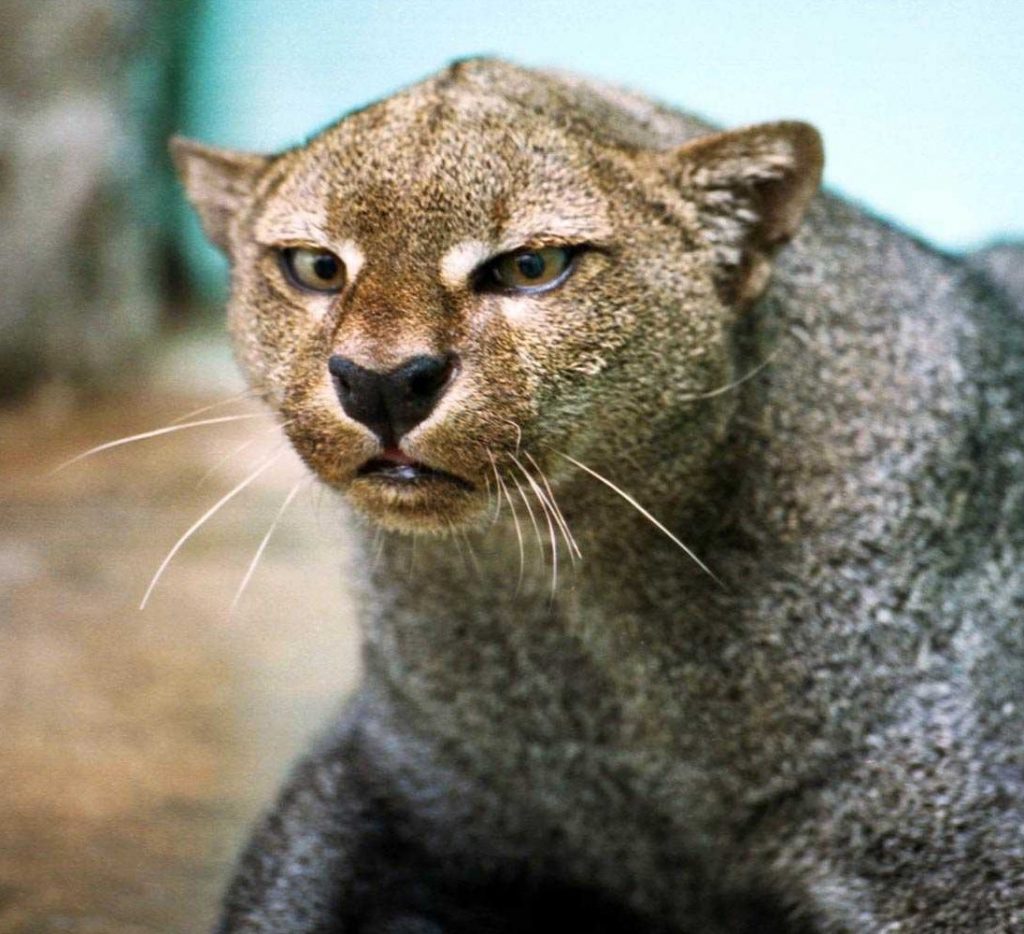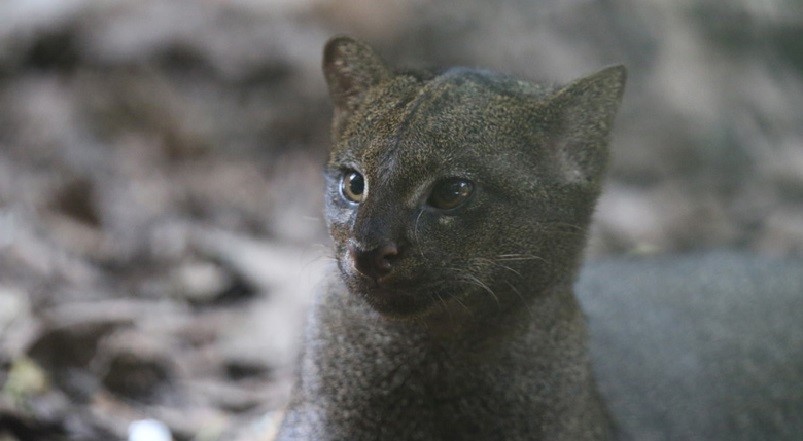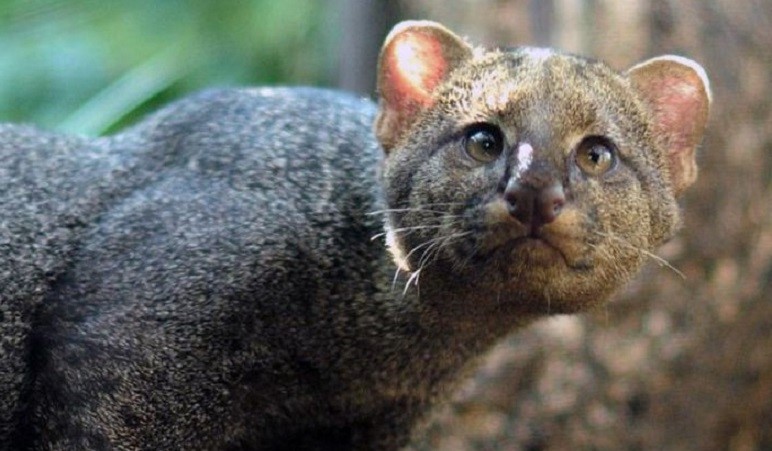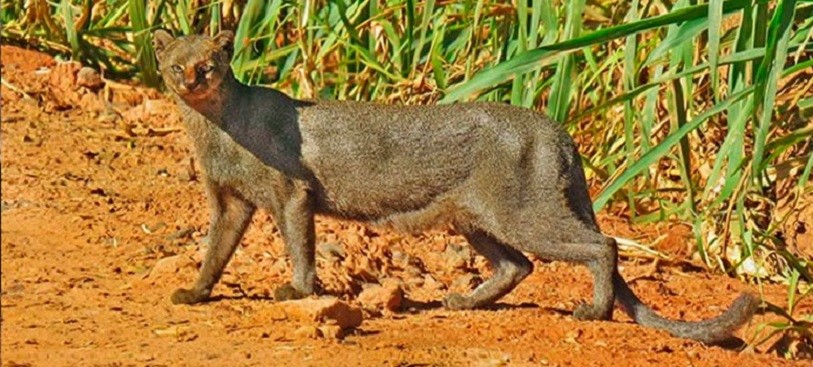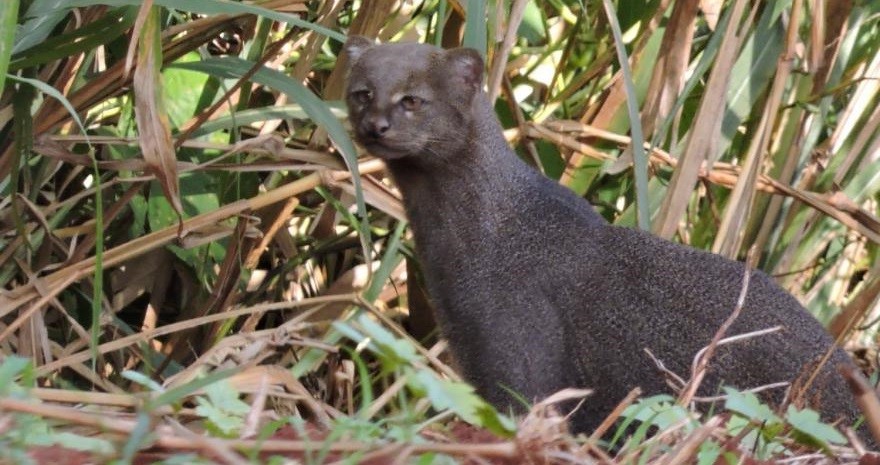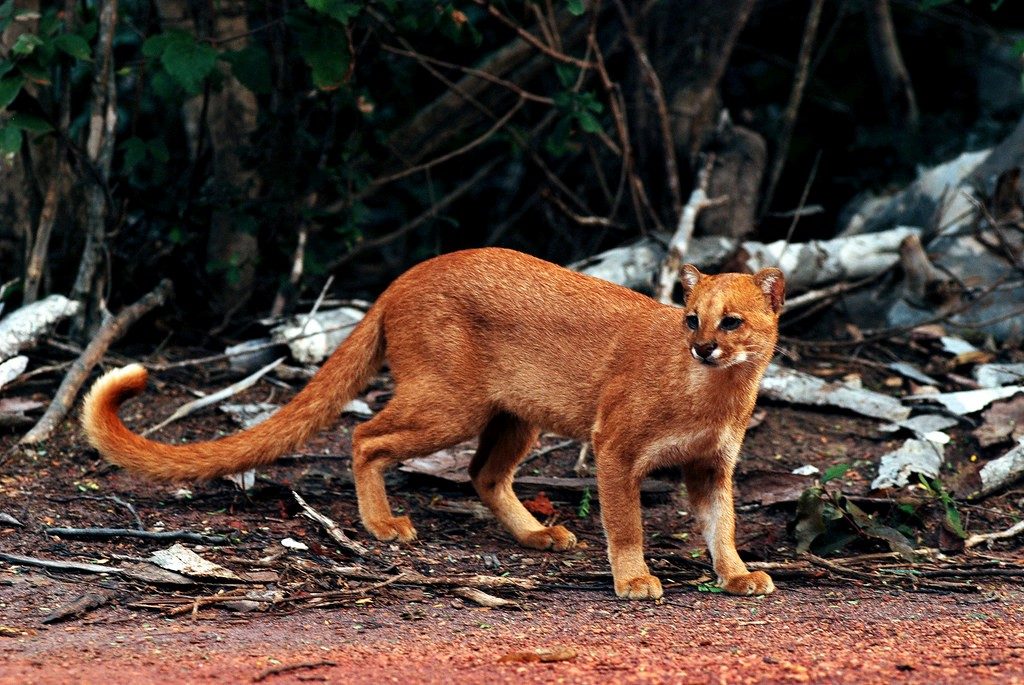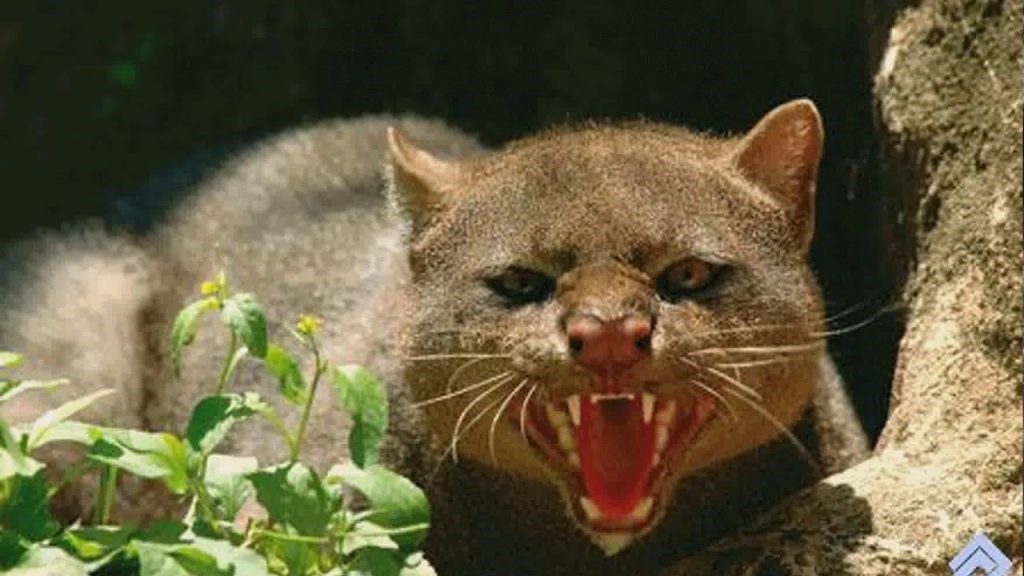
🐾 Jaguarundi Cat: Your new pet
The jaguarundi cat or eyra, scientifically called Herpailurus yagouroundi, is a wild feline. This breed is endemic in most regions and countries of the Americas, where it is part of the typical wildlife of the tropical, dense, and abundant rainforest vegetation. Recently, the expansion, or rather interference, of humans and their activities, mainly agricultural, in the habitat of this breed have caused population changes in the Jaguarundi. These changes negatively impact their maintenance and preservation.
They are unique-looking wild cats, sometimes called «otter cat» thanks to its peculiar characteristics. The Jaguarundi is a cat of small dimensions among wild cats, with a body of thin and fine lines, and short yet agile legs. It has a long tail that almost equals the length of its body, in addition to a long neck that holds a small rounded head with small eyes and ears. It, without a doubt, has an unmistakable appearance. Furthermore, this kitten has a coat of solid and uniform colors, brown, black, or gray tones being the usual. Nevertheless, experts have proven that the color of the fur varies according to the area where it lives if it is more humid or dry.
In his personality, the Jaguarundi cat is a cunning and smart feline, as well as being extremely fast and agile, and loving to swim. It can jump up to two meters high, if it is going to hunt a bird, and it can climb between the branches, it prefers, however, the ground. The Jaguarundi carefully chooses its prey, feeding on small animals that are light and easy to catch, although it is brave and daring, sometimes hunting armadillos. They are essentially carnivorous animals in terms of food. Nevertheless, the Jaguarundi has learned to eat grass and fruit, among other alternative foods. This change of diet is a consequence of the environmental impact on their natural habitat that has caused the population of prey to decrease.
They are the farmer’s nightmare. The Jaguarundi cat has learned to be a chicken hunter when they live in areas near farms or rural houses. This activity has earned them the nickname «fox cats» and has made them the enemy of farmers, turning into hunting targets. It is important to be cautious in home areas that are close to the habitat of the Jaguarundi cat, as it can be dangerous for pets, children, and people. It is not a domestic cat, is a wild cat, hence why is not very sociable.
As for this cat’s health, the Jaguarundi is very strong and healthy, without any known genetic diseases in this breed. The female’s reproductive period lasts about two months, and she can birth a maximum of four kittens at a time. The kittens stay with their mother for at least two months, training to become independent afterward. The Jaguarundi becomes an adult at around two years of age, being a strong breed with a life expectancy that reaches 15 years.
The best way to take care of this wild cat breed is taking care of nature, environment, forest, and vegetation that are typical of this feline. Informative campaigns about potentially endangered species are useful. They teach us to value, and take care of animals in our land such as the Jaguarundi cat.
🐾 History and Origin
The Jaguarundi cat is a very popular feline in the Americas, a territory in which it receives numerous names. They call it “Yaguarundi puma” or «yagouaroundi», due to its scientific name. This feline is part of the family Felidae, and you can find it in nearly any region of the American continent. You can run into it in the forest and mountains of the United States, in the north. And they extend to the cold hills of Patagonia, Argentina, in the south. The Jaguarundi is a common feline that belongs to the natural wildlife of the western lands of the Americas.
It is a wild cat, and it can reside in mountain areas, near homes, although it is not common to have it as a pet. According to the region of the continent where they are, their name may vary due to the local culture. The Jaguarundi cat is also known as the Moorish cat, preto cat, otter cat, red cat, fox cat. Moreover, tigrillo, little lion, the Breton lion, lizard cat, dog cat, and yaguarundi cat are some of its names. Its name “Yaguarundí” comes from the Guaraní language, and means “cat”.
The weasel cats, Jaguarundi, despite being endemic in our continent, experts estimate that the shocking changes in its environment and habitat have affected its population. In the future, this may be the cause of the breed becoming a species in danger of extinction. Currently, the International Union for Conservation of Nature (IUCN) classifies the Jaguarundi cat within the category of «minor concern». Nonetheless, several biologists and scientists suggest making a more accurate review of this status. It is not a frequent hunting target since its fur is unicolor, even though, when other predators are missing, the Jaguarundi can turn white.
Additionally, significant aspects have affected the conservation status of this feline breed. Climate change and the expansion of town planning towards natural areas are just some actions that have compromised it. Then again, it seems relatively easy to evaluate the status of the breed since these cats can be seen during the daytime thanks to their behavior. They are very common in the Western Hemisphere regions, and the absence of colorful fur protects them from the hunters to some extent.
Nonetheless, in the United States, the Jaguarundi cat is an endangered species since the past century due to its rare and confusing sightings in the country. Being a cat with such a distinctive morphology and easy to recognize, not identifying or tracking them in common areas has worried many biologists and researchers. These experts from various natural environments and species conservation societies are carrying out an exhaustive study of the area to identify the status of the Jaguarundi cat breed.
🐾 Breed characteristics
The Jaguarundi cat is a feline with unique looks. Thanks to the rarity and the characteristic of its body, it is practically impossible not to recognize such a peculiar kitten. Truly, the characteristics of the Jaguarundi cat remind more of a mustelid than a cat itself.
The Jaguarundi is a small-sized feline when compared to other felines of similar groups. It barely achieves a size of 50 to 70 cm long and with a height of barely 30 or 35 cm. As for its weight, the Jaguarundi cat can weigh between 4 and 10 kilograms, and the females of the breed are smaller than males, rarely weighing more than 6 kilograms.
A long tail is very representative in this breed, which can be as long as the cat’s body, that is, about 30 to 60 cm. If we include the size of the tail in the general measures, the Jaguarundi can reach up to 130 cm in length.
This cat has a long body, thin and skinny, with delicate lines. The legs are a bit thick yet short, in which the back claws are not completely retractable. The head is small, and rounded, extended by an unmistakable long neck. It has a pair of round, small, and dark eyes, and a pair of elongated, small, and rounded ears are on top of the head. All of these unique traits make us think of an otter, hence why «cat otter» is one of its names.
The whole body has a coat of dense, short, and thick hair, which is of unvarying tones and solid colors, without any marks or characteristic pattern. The most common colors of this fur are brown, copper, or reddish tones. Nevertheless, gray, black, and some shades of yellows also show, and make them look even more like mustelids. It is common to see that the color tone in the head is slightly lighter than in the rest of the body.
The fur colors also change according to the animal’s habitat. For instance, Jaguarundi cats that live in areas of thick and abundant vegetation have dark fur tones, unlike those felines that inhabit the valleys and have coats of lighter tones. This tone variation is likely a survival strategy to camouflage and blend with vegetation, which is particularly useful when hunting for food.
The Jaguarundi is a smart, agile, and cunning cat. He is a great swimmer and climber, even capable of chasing prey in the heights, reaching more than two meters since they are innate jumpers. It is a strong and resistant cat, perfectly adapted for a life in the mountains or areas with a lot of vegetation. In recent years, they have suffered numerous changes in their natural environments. These changes decreased the sightings of the Jaguarundi cat, and have led scientists to believe that in Uruguay and the United States, it has gone extinct.
🐾 Nature and personality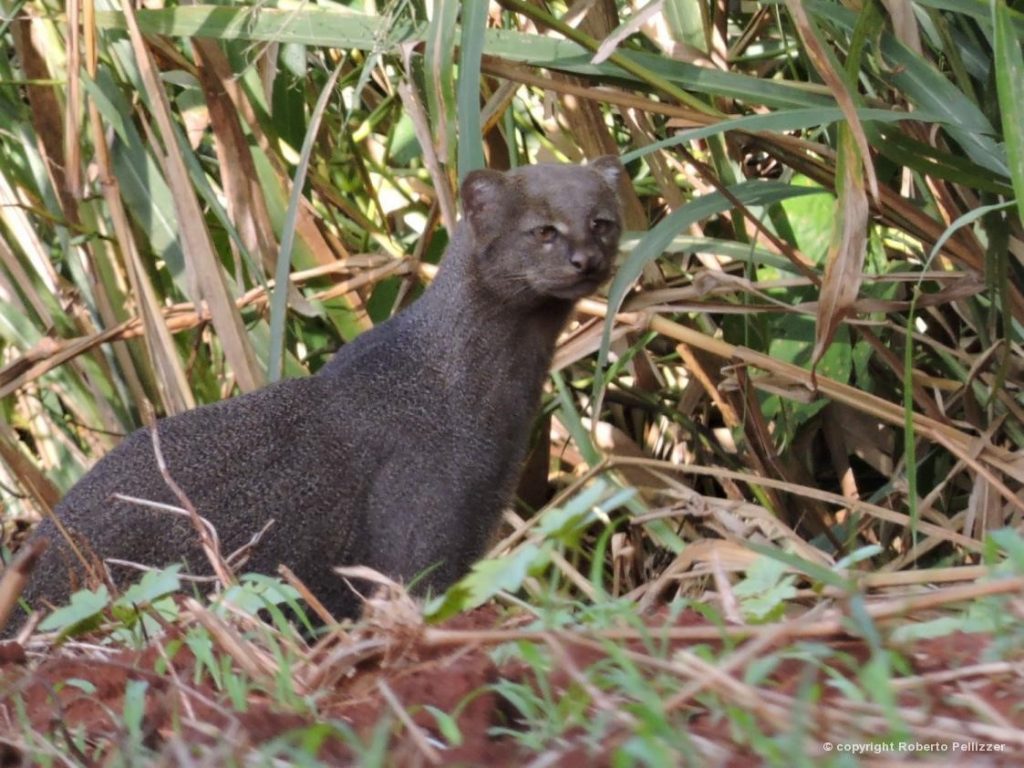
Unlike many other cat breeds, which are also wild species, the Jaguarundi cat is a feline of diurnal habits. To be precise, they remain active throughout the day, while they use the night for resting and refilling their energies. This activity cycle is contrary to many other carnivorous species, even wild cats.
Experts believe that this behavior, with a natural day and night cycle, is a routine recently developed due to the coexistence of new felines in their habitat. These felines include the ocelot, the jaguar, and the puma, which are at the same food chain level as the Jaguarundi cat. The introduction of these felines in their environment is another agent of the great environmental impact that harms all these breeds of tropical felines. In consequence, they have to change their behavior and lifestyle to face competition for food.
Jaguarundi cats are patient and tolerant animals. According to expert’s studies and observations, these felines can be in habitats near homes. They can tolerate the presence of humans, and can easily adapt to environmental changes, more than other breeds of animals and felines. Many believe that this breed has resisted the environmental impact and the threat of extinction.
However, when they live in environments that are close to humans, they become the target of hunters. This situation occurs, particularly, since they tend to chase domestic chickens in farming regions that have been expanding to their habitat. Along with being excellent hunters, they also became the hunting target of farmers.
While he is a good jumper and balances well, the Jaguarundi cat manages best on flat ground and soil. He can move with impressive skill and agility on these lands, ready to catch his prey with great ease. It is very fast and skilled between the branches of the trees in the heights, and it can jump to chase birds, and moves easily from one branch to another. To maintain its movement freedom with such a respectable balance, it uses its long tail as a stabilizing device in the heights. This tail is a natural adaptation of the species developed from the location in which it lives.
It is not a cat that can be a common pet at homes, even if on some occasions a few curious people have domesticated it. There are not a lot of stories about their experience with humans. Although, it is tolerant, receptive, and capable of adapting to people and the changes they generate in their habitat and environment. In general, the Jaguarundi cat is not aggressive, whereas it is quite curious and adventurous. It is a fun species to observe, being part of many rural regions of the American continent and, therefore, needs respect, care, and attention for its preservation.
🐾 Diet and nutrition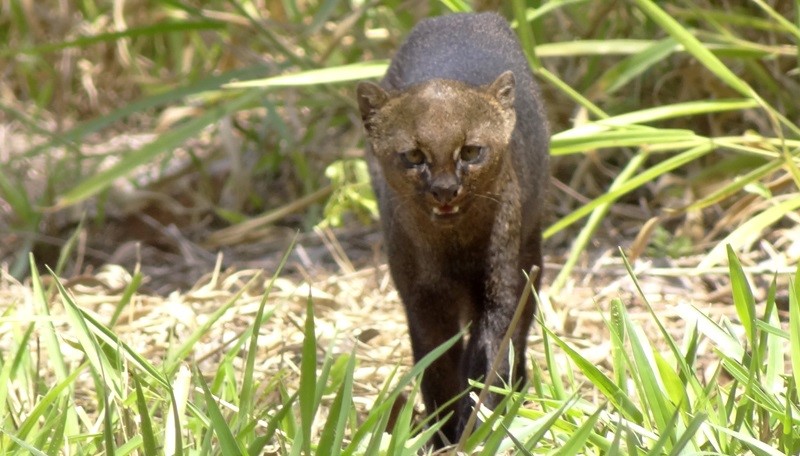
The Jaguarundi cat, like all felines, is an animal with predatory eating habits. Accordingly, it has developed excellent hunting skills that have been improving and adapting according to the changes in its environment and habitat. Its food practically results of the behavior of the animal in nature. As this is a wild cat, it depends on the amount of prey in the environment, and the degree of food competition with other predators in the same food chain level.
The Jaguarundi cat feeds mostly on small animals, usually mammals with a kilogram maximum of weight. Their diet includes rabbits, hares, rats, mice, and other vermin, as well as several birds. Sometimes, they also eat reptiles, for instance, lizards and some species of snakes. On a few occasions, individuals have reported that the Jaguarundi has been able to hunt even larger animals. While they are moments of exceptional hunting, it has captured opossums, ferrets, and even armadillos.
This mammal has had to live with humans instead of its natural habitats. Therefore, it is forced to look for other types of food. In this sense, the Jaguarundi cat can be a real nightmare for farmers. When it is in the surroundings of the barns, this cat is an expert in stealing chickens, hence why some know him as a fox cat.
Unfortunately, the Jaguarundi’s hunting, as an alternative to finding food, has made this cat breed a chasing target for many farmers. This hunt, in addition to the impact of environmental modifications on their natural habitats, results in the loss of the Jaguarundi wild cat breed. Furthermore, the Jaguarundi that lives near humans is dangerous for small pets, for example, rodents such as guinea pigs, and even domestic cat breeds. Occasionally, it can be aggressive with children, so you have to be extremely careful at homes near its habitat.
On the other hand, the Jaguarundi is a great swimmer, so he also can feed on fish and other amphibians, when these environments are near its habitat. The Jaguarundi carefully selects its prey, being an extremely clever cat, it seeks hunting small animals of little weight that are easier to chase and capture. Nevertheless, it sometimes tends to be fearless and is encouraged to hunt heavy and large animals, like the armadillo.
Adaptation, in some regions with insufficient food and the food competition with other predators, is intense. The Jaguarundi cat, being predatory par excellence, has been forced to develop vegetarian habits. It feeds on grass, insects, and even fruits to survive in such hostile environmental conditions.
🐾 Health
The Jaguarundi cat usually has a long life expectancy, which reaches around 13 to 15 years of age. It is a breed of wild cats, which mostly keeps a lonely lifestyle, seeks company when it needs to reproduce, and spends most of the year alone. They are really strong and healthy cats, with few diseases affecting them. There are no known genetic or hereditary diseases particularly linked to this breed.
As for the life cycle of the Jaguarundi cat, they are born from a female that usually has about four kittens in each birth. The mother takes the Jaguarundi kittens to the caves or shelters that they dig themselves. After being born, Jaguarundi cats are blind and deaf, entirely dependent on their mother during their first month of life for exclusive feeding through breastfeeding.
After their first month, when the first teeth sprout, the Jaguarundi is ready to start trying another type of solid food, which is brought to the shelter by the mother. At this stage, they begin a mixed diet, experiencing new textures and flavors, simultaneously with breastfeeding. Around the 28th or 31st day of life, the Jaguarundi cats begin to leave the shelter and become familiar with the outdoors. They will soon have to start living without the protection and care of the mother.
From this moment, when the Jaguarundi kittens leave the burrow, the mother is in charge of training them to develop the necessary behaviors and conducts for their survival. This way, by imitation, the Jaguarundi cats begin to learn about animal hunting strategies, jumping, swimming, running agility, and so on, all with the observation and training of their mother. This process of adaptation and learning about the environment happens in the second month of this cat’s life.
Finally, around two or three months of age, the Jaguarundi cat is ready to become independent and begin to improve its hunting and survival activities. Little by little, the cats separate from the mother and begin their lonely journey by testing and perfecting innate and acquired skills.
With the cat’s growth, sexual maturity arrives, which happens at around two or three years of age, without having a defined time or period for reproducing. Experts have observed in Jaguarundi kept in captivity that they can reproduce two times every year.
After reproducing, the female goes through a gestation period that lasts about two and a half months, or 63-75 days on average. During the gestation stage, the Jaguarundi female prepares to receive the kittens and looks for a cave or digs a shelter. She takes refuge when she is close to childbirth and waits for the birth of her kittens, and the cycle starts again.
🐾 General Care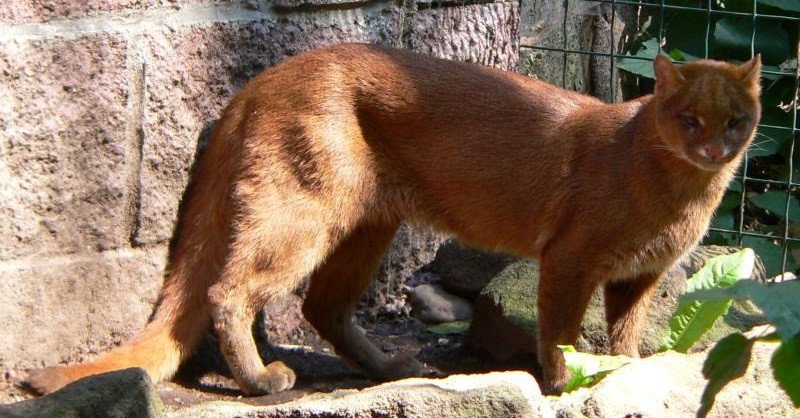
The Jaguarundi cat is a wild feline that lives in regions of dense vegetation in the American continent, from the United States to Argentina. Experts say that it is an endemic cat, popularly known with a wide variety of names according to the region of the continent where it is.
Therefore, general care for this breed aims at protecting its environment and its habitat. People can achieve this by reducing contamination and the loss of areas of this wildlife, towards which human activity has incredibly expanded in recent years.
Although conservation centers do not consider it as a universally endangered breed, the number of sightings in countries such as Uruguay and the United States has drastically reduced. As a result, biologist and conservationists are conducting research and various studies on this breed. The progressive disappearance of their habitat has caused, among many other environmental impacts, the redistribution of carnivores, which increases competition for food. These factors have damaged the survival of this feline.
The humid tropical forest is the ideal habitat of the Jaguarundi cat, in which they spend most of the time on the ground, being great climbers and jumpers. Maintaining and conserving these regions is crucial for the care of the breed. Jaguarundi cats need a dense forest that is home not only to them, as hunters, but also to animals that serve as prey. Predators and prey, such as small mammals, birds, reptiles, among others, are essential to maintain the food chain.
This breed’s felines also spread among split or minor forests, included inside farming landscapes, in which rats are the perfect food. Therefore, it is vital to protect the wildlife of these habitats in harmony and balance. This preservation will not only keep the Jaguarundi cat breed but also all the flora and fauna that belongs in that tropical region.
The Jaguarundi enjoys lands with low brushes in the middle of thorny forests, with fields and gallery forests. In countries such as the United States, experts have issued alerts on the current status of the breed. However, not all conservation organizations have uniformly accepted the declaration of «endangered race». Biologists are currently carrying out numerous studies to determine the present situation of Jaguarundi cats.
Actions for its conservation and protection include the end of deforestation of its habitats, and avoiding forced captivity to be a pet cat, as it is a wild cat. Perhaps, a crucial and extremely important aspect is education and spreading information to the community about the reality of the dangers the beautiful Jaguarundi cat breed faces. Education will allow the establishment of the needed awareness to generate concrete actions that will save the future of this breed.


